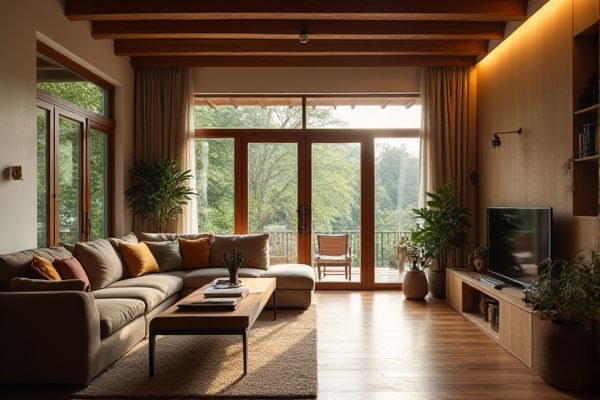
Motion lights activate automatically when movement is detected, enhancing security and energy efficiency, while standard lights operate continuously or via manual switches, potentially leading to higher energy consumption. Explore the rest of the article to discover which lighting option best suits your needs and environment.
Table of Comparison
| Feature | Motion Light | Standard Light |
|---|---|---|
| Activation | Triggered by motion sensors | Constant or manual switch |
| Energy Efficiency | High - only on when needed | Lower - continuous power use |
| Security | Enhanced - deters intruders | Basic - no automatic activation |
| Installation | Requires sensor setup | Simple wiring and switch |
| Cost | Higher initial investment | Lower upfront cost |
| Use Cases | Outdoor paths, security zones | Indoor rooms, general lighting |
| Maintenance | Sensor checks needed | Minimal maintenance |
Introduction to Motion Lights and Standard Lights
Motion lights activate automatically when detecting movement, enhancing security and energy efficiency by illuminating only when needed. Standard lights provide continuous illumination regardless of activity, offering consistent lighting but potentially increasing energy consumption. Choosing between motion lights and standard lights depends on your need for convenience, safety, and energy savings in different areas of your space.
Key Differences Between Motion Lights and Standard Lights
Motion lights activate only when movement is detected, offering energy efficiency and enhanced security by illuminating dark areas sporadically. Standard lights remain on continuously or are controlled by manual switches, providing constant illumination regardless of activity. Motion lights incorporate sensors such as infrared or microwave technology, while standard lights rely on traditional circuits without automatic detection features.
How Motion Sensors Work in Lighting
Motion sensors in lighting detect movement using infrared, ultrasonic, or microwave technology to trigger lights automatically. These sensors improve energy efficiency by activating lights only when someone is present, unlike standard lights that remain on regardless of occupancy. By responding dynamically to motion, motion sensor lights enhance security and convenience in residential and commercial spaces.
Energy Efficiency: Motion Lights vs Standard Lights
Motion lights conserve energy by activating only when movement is detected, leading to significant reductions in electricity consumption compared to standard lights that remain on continuously. Standard lights typically use more power due to extended operating hours, whereas motion-activated lighting systems optimize energy usage by limiting light operation to necessary periods. Studies show motion sensor lights can cut energy bills by up to 70%, making them a highly efficient alternative for both residential and commercial settings.
Installation and Maintenance Comparison
Motion lights typically require more intricate installation due to sensors that must be positioned for optimal detection, while standard lights have straightforward wiring and mounting processes. Maintenance for motion lights involves occasional sensor calibration and battery replacement if cordless, whereas standard lights primarily demand bulb changes and wiring checks. You will find that motion lights offer enhanced energy efficiency but may need more frequent technical attention compared to the simpler upkeep of standard lighting solutions.
Security Benefits of Motion Sensor Lighting
Motion sensor lighting significantly enhances security by instantly illuminating areas when movement is detected, deterring potential intruders and increasing visibility around property perimeters. Unlike standard lights that remain on continuously, motion-activated lights reduce energy consumption and create a dynamic lighting environment that captures suspicious activity more effectively. Studies show properties equipped with motion sensor lights experience lower rates of burglary and vandalism due to the immediate alert and visibility these lights provide.
Cost Analysis: Motion Lights vs Standard Lights
Motion lights typically have higher upfront costs compared to standard lights due to integrated sensors and advanced technology. However, the energy savings from motion-activated lighting often lead to lower electricity bills and reduced operational costs over time. Standard lights may have lower initial expenses but can result in higher energy consumption and maintenance costs in the long run.
Practical Applications for Each Type
Motion lights excel in security and energy efficiency, automatically illuminating areas such as driveways, pathways, and entry points only when movement is detected, reducing electricity consumption and enhancing safety. Standard lights are ideal for consistent, continuous illumination in indoor spaces like offices, classrooms, and living rooms, providing steady lighting essential for tasks and ambiance. Both lighting types cater to specific needs: motion lights prioritize responsive activation in outdoor or security settings, while standard lights maintain uniform brightness for comfort and usability indoors.
User Experience and Convenience
Motion lights enhance user experience by providing automatic illumination upon detecting movement, eliminating the need for manual switching and improving convenience in dark or high-traffic areas. Standard lights require physical interaction to turn on or off, which can be less efficient and less seamless, especially when hands are occupied or in unfamiliar environments. Motion lights also contribute to energy savings by activating only when necessary, offering a smarter, more user-friendly lighting solution compared to traditional fixtures.
Choosing the Right Lighting for Your Needs
Motion lights provide energy efficiency and enhanced security by activating only when movement is detected, making them ideal for outdoor areas and irregular use. Standard lights offer consistent illumination suitable for indoor spaces or locations requiring constant lighting, ensuring steady visibility. Selecting between motion and standard lights depends on your specific requirements for energy savings, security, and continuous light coverage.
 homyna.com
homyna.com